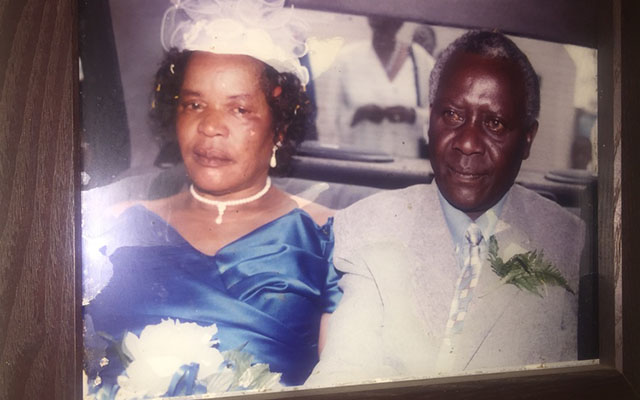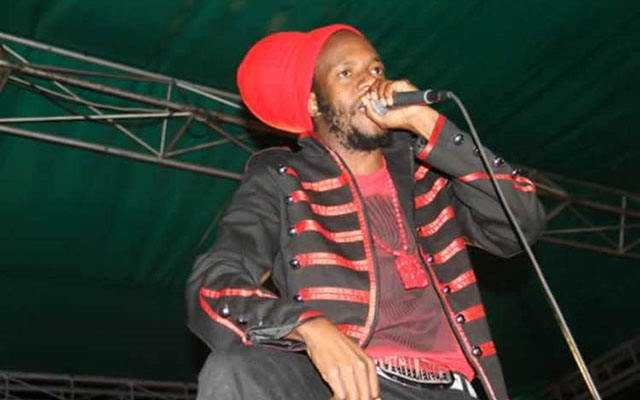GEORGE SHAYA PROVIDES A CONTRAST OF A PAST ROOTED IN HEROISM AND A PRESENT HAUNTED BY A GHOST OF ISOLATION


This picture, hanging on the walls of Zimbabwe football legend George Shaya’s Glen Norah, Harare, house, shows the superstar and his wife Agnes on their wedding day back in the day when he was the posterboy of domestic football
SHARUKO ON SATURDAY
images on the walls of the living room tell their own powerful story — a reminder of a time when the dominant figure in those pictures, some in black-and-white and others in colour, was a football god.
A vintage collection of memories from a past when this diminutive figure used to have golden feet that represented greatness and in whose talents millions of fans used to invest their trust, and hopes, for the delivery of something special.
As if to celebrate, in a way, that which the football gods gave to him in abundance, in a career in which he touched the heavens and made such a huge impression he remains a reference point, when it comes to brilliance, in the game in this country almost 50 years to the day he won his first Footballer of the Year crown as a 23-year-old.
Maybe, by design or default, 1969 — when this little fellow whose images now decorate his living room was first honoured as his country’s finest footballer — was just a year reserved for greatness as it also marked the first time that man walked on the moon with American astronaut Neil Armstrong getting that honour on July 20, ’69.
Since that initial Armstrong step on the moon, 11 others — ironically the number of players needed to make a football team — have walked on the moon and, just to show that this isn’t Mickey Mouse stuff, none of them has made a second trip there.
And, for this diminutive fellow, almost half-a-century of days, weeks, months and years have come and gone since that day when he came of age, finally being honoured by his country for his unique football talents, with time failing to erase memories of his genius and, remarkably to this day, he remains a reference point of greatness.
But while time has failed to wipe away his legacy, to consign his greatness into the bin where the world dumps its forgotten memories, it’s easy to notice — when you step into that living room — that time has also been cruel to him, in the second and final half of a life lived in the spotlight since his privacy was lost to the genius of his feet.
And those images hanging on the walls, a throwback to a time when he was the ultimate superstar, which stare glaringly on any visitor who comes into his living room as if to remind you that you are stepping into a special enclosure whose resident isn’t cut from the cloth that makes ordinary folks, also have a deeper meaning.
It’s as if they are meant to make him curse both fate and time which — for an athletic superstar like him — combined to give so much, in natural gifts, before taking it all away in a ruthless reminder of our mere mortality as human beings who are forever at the mercy of the ravages of the changing seasons.
Long before Moses Chunga and Peter Ndlovu came along, and transformed themselves into the ultimate symbols of football purity in this country in the ‘80s and ‘90s, there was this little fellow whose images, from that golden past when he was so good they even nicknamed him “The Mastermind”, are now plastered on the walls of this modest Glen Norah, Harare, house.
George Shaya, the Mastermind, sits on a sofa glued to his television set which, probably fittingly, is showing some football game.
He is frail, but certainly not as bad as might have been suggested in the last newspaper story about him published just a few days before our visit, which appeared to suggest he was a bed-ridden man whom time, and a football constituency he served with distinction, had combined to forget.
Certainly, he doesn’t in any way, appear to be a new millennium version of Miss Havisham, in Charles Dickens’ classic novel Great Expectations, who turns herself into that ghostly character after suffering a mental breakdown by imprisoning herself for years in her decaying mansion, Satis House, having vowed never to remove her wedding dress and the wedding cake from the table.
While, also, stopping the clocks at twenty minutes to nine — the time she received a letter from her fraudulent lover, informing her on her special day, that the wedding was off and their relationship had ended.
He doesn’t speak much, with all the talking left to his devoted wife Agnes, his partner for the last 40 years, who got married to him in the last year George was honoured with his fifth and final Soccer Star of the Year award in 1977 — and his third in succession — at a time when he was at the very peak of his athletic powers.
But, it doesn’t take long for me to finally see that all isn’t what it looks like, that something is very, very wrong here and it comes when George mistakenly refers to me as a Karoi businessman he used to know, who has come to visit him, until someone reminds him that I am the journalist he has worked with for a long time.
It becomes very clear dementia, also known as senility, a brain condition that causes one to forget things and events, is taking its toll on King George.
It’s is also clear to me it’s a present George yearns to escape from while his past – his legacy, his greatness, his enduring popularity which has stood the test of time and his unquestionable brilliance on the football field – is what the scores of youngsters I had just met on the streets of his Glen Norah neighborhood are all hoping for in their cocktail of dreams.
Watching this stricken star in the place he calls his home, far away from the madding crowd that used to virtually worship him, one gets overwhelmed by the brutality of the contrast of a yesterday rooted in heroism — and all the razzmatazz that came with it — and a today haunted by the ghost of isolation.
A STRIKING IDENTICAL TALE OF TWO FOOTBALL GEORGES
At least, our George still lives to this day, a 70-year-old man who has been blessed with as much life as the football gifts that made him a superstar.
His namesake, George Best, the Northern Irishman who — like our George — exploded on the big stage in the twilight years of the Swinging Sixties as the world football’s first celebrity superstar, died 12 years ago at the age of 59, after a troubled life in which he battled alcoholism and, in his words, ‘’spent a lot of money on booze, birds (women), fast cars (while) the rest I just squandered it.’’
Dubbed “The Fifth Beatle’’ by the Portuguese media in 1966, after scoring twice in Lisbon to help Manchester United beat Benfica in a European Cup quarter-final match while still only 19, George Best would go on to be crowned the European Footballer of the Year, two years later, win the Ballon d’Or and the European Cup with the Red Devils in the same year, all this coming when he was still only 21.
But for all his combination of greatness and recklessness, including a playboy lifestyle many blame for virtually ending his career — on the big stage — at the young age of 27, George Best even received a donor for a liver — possibly damaged by his alcohol abuse — as the British football family refused to abandon him.
His country renamed the Belfast City Airport in his honour while, in February, a leading Liverpool hotel group announced they will shatter the barriers that divide the two cities — epitomised by the deep rivalry between the cities’ biggest and most successful football clubs — by building an exclusive hotel in Manchester in honour of George Best.
Five years ago, England’s national football team players and their FA bosses donated £40 000 to help pay the medical costs of the country’s hero of the ’90 World Cup finals in Italy, Paul Gascoigne, whose life also spiralled out of control mainly because of alcohol abuse.
The donation was channelled through the official charity, the ‘England Footballers Foundation’, which has raised more than £3 million since its formation in 2007.
Gazza’s treatment in the United States required about £7 500 every week and John Terry, who also donated an undisclosed substantial sum in his personal capacity, said it was for a worthy cause.
“In Italia ‘90, Gazza became mine and the nation’s hero. His performances and pride made him stand out and I enjoyed watching him play while I was growing up,’’ Terry told the media.
And, because of the support he has received from his colleagues, Gazza lives to this day.
IF OUR FOOTBALL CAN’T HELP GEORGE, THEN WHO CAN IT HELP?
When ZIFA president Philip Chiyangwa told me on Sunday that the time had come for him, and the football organisation he leads, to take a leading role in ensuring that legends like George Shaya don’t have to live like destitutes given the key role they play in our national game, I felt a refreshing wave of relief sweeping through my soul.
And when Chiyangwa asked me if I could accompany them to George’s Glen Norah house, I gladly accepted the invitation and to be there in that living room, to feel those waves of emotions as ZIFA unveiled the George Shaya Benefit Fund, with the Association announcing an injection of an initial $3 000 into it for this legend to take care of his needs, including medical requirements, was too much to bear.
Chiyangwa then gave the Shaya family $300, from his own personal funds, to enable them to take care of their immediate means while ZIFA finalised the establishment of the Benefit Fund and also looked for more sponsors, like BAT Zimbabwe who — back in the ‘70s — turned to George for a poster boy to sell their cigarettes, to pour their money into this fund.
Watching all this unfold, as George’s wife Agnes battled tears, at times choking as she struggled for words to chronicle the challenges the family have gone through, I felt an overpowering sense of relief to be a witness to what was unfolding in that Glen Norah living room as football, which this family had been cursing for turning its back on them, extended that helping hand.
The easiest thing is to just move on, forgetting people like our George, because they belong to the past and what is probably more important, in the eyes of some, is the future, where we go from here, instead of imprisoning ourselves to a bygone era.
But, just for a second, imagine if the South Africans had turned their back on problem child Jabu Mahlangu, who used to be known in the past as Jabu Pule, whose potential to really become the superstar that his raw talent deserved, and cast him into the dustbins of history because he messed up a career that could have made him an icon?
“I know I shouldn’t be alive today,” Mahlangu candidly told the South African media after career ruined by alcohol and drug abuse which saw him being kicked out of three clubs — twice sent into rehabilitation clinics to try and tame this monster that was devouring him — and expelled from an Austrian club, after just eight months, for crashing his car while being hopelessly drunk.
But the South Africans refused to abandon their bad boy, found a way to rehabilitate him against all the odds and, today, he has cleaned his mess — thanks to the support he received from his country — and reinvented himself into a television pundit for SuperSport.
Mahlangu was never as good as our George, something which Jomo Sono — a legend in his own right who was at the receiving end of a Mastermind Masterclass on a rain-swept afternoon at Rufaro in 1976 when Dynamos ran riot to thrash Orlando Pirates 4-1 to be crowned champions of Southern Africa — will probably testify if you ask him today.
My colleague on ZTV’s flagship weekly football magazine show Game Plan, the legendary Charles “CNN’’ Mabika, even argues George Shaya is the greatest Zimbabwean footballer of all-time.
And, Charlie isn’t alone with our colleagues at The Patriot newspaper even going to the extent of calling George Shaya “Zimbabwe’s Maradona’’ in a piece published in May 2011.
Elijah Muponda, who penned that personal piece, remembered the 1973 Chibuku Cup final at Gwanzura when George turned a game, which Dynamos were losing 2-3 going into the final minute, on its head when “the little man magically weaved his way past a couple of players (and) then unleashed a ferocious shot’’, for the last-gasp equaliser.
“This was George Shaya at his best and many soccer fans had witnessed many magical moments from this diminutive Dynamos right winger. This is the same player whose brilliance had forced me to drive all the way from Rusape with my friends to witness this last major Cup Final to be staged at Gwanzura before soccer moved to Rufaro.
“Riio Tinto were soundly thrashed 6-2 in the replay in the first major Cup game at Rufaro and the chief destroyer was George Shaya. I am a great soccer enthusiast, and as I go down memory lane, I find Shaya to be arguably the finest soccer player the country has ever produced.’’
Others will, rightly, question what about Peter Ndlovu, what about Bruce Grobbelaar, what about Moses Chunga, what about Freddie M’kwesha, what about the Dusty King, Freddie Gotora, many other iconic local footballers who can lay claim to the title of greatest of all-time?
But, this week, isn’t about comparisons, this is about our football rediscovering its soul, finding its way back into the light after years of staggering in the darkness and, in the process, reaching out to find a forgotten King badly crying out to his kingdom for a helping hand.
Who said Pele was wrong to say this is the most beautiful game in the world?
TO GOD BE THE GLORY!
Come on United!!!!!!!!!!!!!!!!
Rashfooooooooooooooooooooooood!!!!!!!!!!!!!!!!!!!!!!!!!!!!!!!!!!!!!!!!!!!!!
Text Feedback – 07192545199 (I migrated to OneFusion)
WhatsApp Messenger – 07192545199
Email – [email protected]
Skype – sharuko58
Chat with me on Facebook, follow me on Twitter @Chakariboy, interact with me on Viber or read my material in The Southern Times or on www.sportszone.co.zw. The authoritative ZBC weekly television football magazine programme, Game Plan, is back on air and you can interact with me and the legendary Charles “CNN” Mabika and producer Tich “Chief” Mushangwe every Monday night at 21:45pm.











Comments